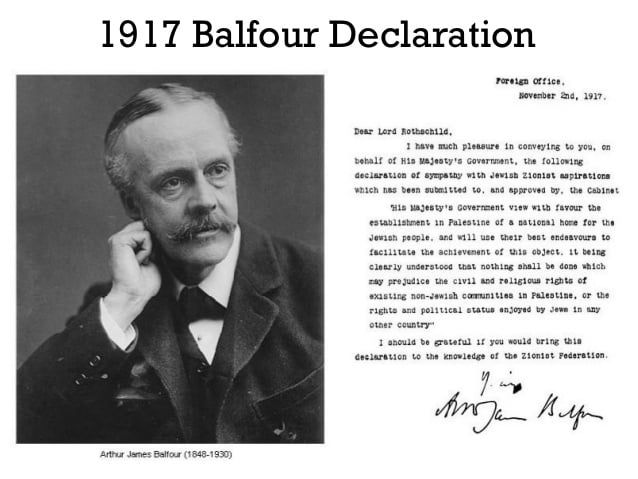Against Our Better Judgment: The Hidden History of How the U.S. Was Used to Create Israel
Review of Alison Weir's Book
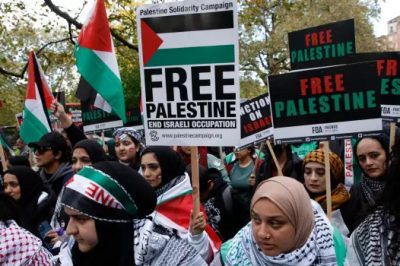
All Global Research articles can be read in 51 languages by activating the Translate Website button below the author’s name.
To receive Global Research’s Daily Newsletter (selected articles), click here.
Click the share button above to email/forward this article to your friends and colleagues. Follow us on Instagram and Twitter and subscribe to our Telegram Channel. Feel free to repost and share widely Global Research articles.
First published on November 1, 2023
***
Introduction
As the crisis involving the Israelis and Palestinians deepens after the October 7 Hamas attack, we might pause to examine how the state of Israel was created in the first place. At the current juncture, as World War III looms on the horizon, as massacres are currently being perpetrated by Israel against the civilian population of Gaza, with a death toll exceeding 9,000, of which over 4,000 are children, and as a Western armada is gathering in the eastern Mediterranean, it is befitting to review journalist Alison Weir’s book Against Our Better Judgment: The Hidden History of How the U.S. Was Used to Create Israel. Click Here The book was published in 2014, is packed with often hard-to-access details, and is masterfully documented. Alison Weir is also head of a group she has founded: If Americans Knew. Click Here
Alison Weir’s book is crucially important in considering ways to gain a broader perspective in order to defuse the situation. It is also of keen interest with respect to the larger potential conflict, where U.S. political leaders are again trotting out the phrase, “Axis of Evil,” this time to describe the nations of Russia, China, and Iran. (Sometimes North Korea is tossed in for good measure.) It’s Iran, of course, that U.S. leaders are identifying as an alleged sponsor of the resistance groups in and around Palestine, including Hamas.
Following are what I view as the main points from Alison Weir’s book.
My own interspersed editorial comments are in italics. Page numbers are given in parentheses only for quotations from the book.
Origin of Zionism in the U.S.
Against Our Better Judgment: The Hidden History of How the U.S. Was Used to Create Israel begins by explaining that support for Zionism, defined as the desire for creation of a Jewish national state somewhere in the world, goes back in U.S. history to the late 1880s, around the time that the Zionist Movement was becoming prominent in Europe.
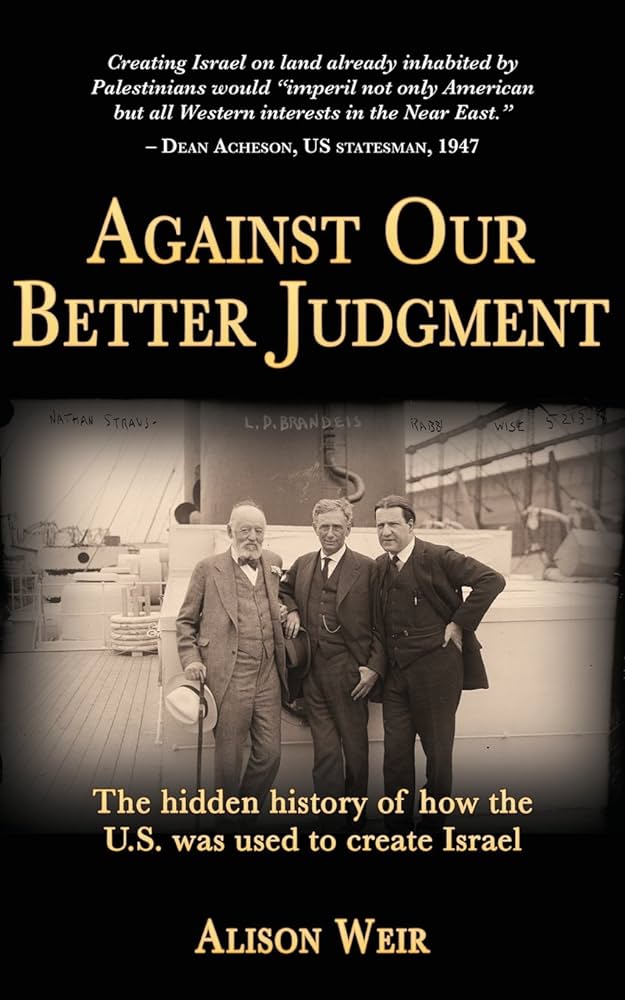
By the 1910s, there were thousands of U.S. adherents, though many Jews opposed Zionism as not in the interests of the Jewish people and certain to result in antagonism toward them. Probably a majority of Jews in the U.S. had never even heard of Zionism and/or were happy to have assimilated into American society. In fact, there was nothing that could even be viewed remotely as an “anti-Semitism problem” in the U.S. at this time.
Role of U.S. Supreme Court Associate Justice Louis Brandeis and Creation of the Parushim.
Still, some very powerful people became Zionists, including U.S. Supreme Court Justice Louis Brandeis, whose main disciple was future Supreme Court Justice Felix Frankfurter. Brandeis formed a secret organization called the Parushim, whose sole purpose was to bring about the creation of a Jewish state in Palestine. This Zionist organization required an oath that appeared to give life and death power over its sworn members.
“Parushim,” also spelled “Purushim,” is the Hebrew word from which the name “Pharisees” is derived, meaning “separatists.” From the Pharisees came Rabbinical Judaism and the idea that, “We should not assimilate or acculturate at all.” (prezi.com) I would note that Alison Weir’s book did not aim at giving an account of the deeper motivations of the Zionist movement, other than its claim to be a reaction to European “anti-Semitism.” For more depth, I would recommend a careful reading of the classic The Controversy of Zion by British journalist Douglas Reed (1895-1976). Click Here
Justice Louis Brandeis was close to Wall Street banker Jacob Schiff. Brandeis was also closely involved with the creation of the Federal Reserve System, as was Schiff, though Brandeis’s involvement in political issues was largely behind the scenes.
The Federal Reserve, I would add, was largely a project of the U.S. Money Trust and the British/European Rothschilds. The Rothschilds were also heavily involved in Zionism and in the creation and support of the Zionist state. The fact that Zionism was sponsored by some incredibly rich people might cause us to ask to what extent financial rewards played a role in the rapid conversion of many Jews and non-Jews to Zionism during this period. For information on creation of the Federal Reserve, see my own book, Our Country, Then and Now (Clarity Press, 2023). Click Here
Collaboration Between the Parushim and Great Britain. Justice Louis Brandeis’s Parushim worked closely with Zionists in Great Britain, including travel back and forth, to persuade the British government to designate Palestine as a future Jewish homeland.
This was after Zionist leaders had rejected such locations as Kenya. Thus was created a “contract” between Britain and the Parushim that if the British would generate what became the Balfour Declaration, the U.S. Zionists would endeavor to assure U.S. entrance into World War I against Germany on the side of Britain. This contract was fulfilled by both parties, though, as in the U.S., many British Jews opposed Zionism for similar reasons—as a threat to Jewish assimilation.
The Balfour Declaration specified that it should be “clearly understood that nothing shall be done which may prejudice the civil and religious rights of existing non-Jewish communities in Palestine.” (p.97) At the time, non-Jewish communities made up 92 percent of the population of Palestine.
Zionism and the Failure to Make Peace with the Ottoman Empire. World War I begin in 1914. By 1915-1916, the Ottoman Empire, which was allied with Germany but not at war against the U.S., offered to make a separate peace with the U.S.
The Ottomans had also offered to allow the Jews of Europe to live at peace anywhere in their empire. The U.S. sent a delegation to negotiate this separate peace, but Brandeis informed the British Zionists that the delegation was on its way.
The British Zionists then send their leader, Chaim Weizmann, to intercept the U.S. delegation at Gibraltar, where he prevailed on it to call off the negotiations.
The reason was that the British were going to lay claim to Palestine after the war as a homeland for the Jews, so they wanted to assure that Palestine was going to be available for British control. The British design was to break up the Ottoman Empire, not leave it intact through a separate U.S.-instigated peace.
Warnings Against the Zionist Project
Diplomats within the U.S. State Department both in Washington, D.C., and in the Middle East were aware of and warned against the Zionist project, arguing that a million Palestinians would be displaced or made virtual servants/slaves of the invaders.
World War I. In 1917 the U.S. entered the war on the side of Britain, per the Zionist agreement, and Germany was defeated, along with the Ottomans. Britain also signed a secret agreement with France by which it would get control of Palestine after the war. Control was implemented through the vehicle of a British Mandate approved by the League of Nations.
During this period, antagonism against Jews had begun to grow within U.S. society, partly in reaction to perceptions that Jews controlled the banks and other financial institutions. “The Protocols of the Elders of Zion” had also appeared. While claimed to be a forgery from Czarist Russia, the Protocols received credence and publicity from Henry Ford and others.
Germany was aware that the Zionists had contributed to the defeat of Germany in WWI. This contributed to the anti-Jewish attitudes of Germans after the war and was a factor in the later Nazi anti-Jewish policies.
During WWI, the Parushim gave the FBI a list of Americans who were opponents to Zionism or the war.
Many of these people were arrested and sent to prison. Through all of this, Brandeis was directing matters from behind the scenes. He was arguably the most powerful person in the U.S., but his political activities were secret or carried out through proxies.
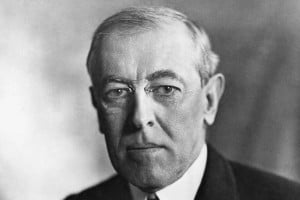 At the end of WWI, President Woodrow Wilson sent a commission to Palestine to investigate the situation. Known as the King-Crane Commission, its report “recommended against the Zionist position of unlimited immigration of Jews to make Palestine a distinctly Jewish state.”
At the end of WWI, President Woodrow Wilson sent a commission to Palestine to investigate the situation. Known as the King-Crane Commission, its report “recommended against the Zionist position of unlimited immigration of Jews to make Palestine a distinctly Jewish state.”
The report stated that “the Zionists looked forward to a practically complete dispossession of the present non-Jewish inhabitants of Palestine,” that “armed force would be required to accomplish this,” and that “the project for making Palestine distinctly a Jewish commonwealth should be given up.” The report of the King-Crane Commission “was suppressed.” (p.25)
Zionism After World War I
Between the two world wars, a growing number of U.S. Zionists worked to further the project for the creation of Israel. In Germany, the Zionists supported the rise of the Nazis, as this would lead to German Jews wanting to emigrate to Palestine. In Iraq, where the Jewish leaders did not support Zionism, Iraqi Jews were attacked, even murdered, to force them to emigrate to Palestine. Without arousing the anxiety of Jews around the world that they were unsafe in their homelands, Zionist planners believed there would not be enough Jewish settlers to create a Zionist state and force the Palestinians out.
Opponents of Zionism in the U.S. diplomatic service were threatened with having their careers destroyed if they did not support the claims that Jews in foreign countries were suffering discrimination so should want to move to Palestine.
The Zionists worked to limit immigration opportunities for Jews elsewhere than Palestine, including the U.S. The Zionists opposed measures by the British government to limit the number of Jews who could enter Palestine.
Collaboration Between the Zionists and Nazis? Building on work by author Hannah Arendt, Edwin Black wrote The Transfer Agreement: The Dramatic Story of the Pact Between the Third Reich and Jewish Palestine. Click Here According to author Tom Segev,
“Arendt stated that many Jews would have survived ‘had their leaders not helped the Nazis organize the concentration of Jews in the ghettos, their deportation to the east, and their transport to the death camps.’” (p.146) This was called the “Haavara Agreement.”
The famous 1930s Jewish boycott of German products may have been instigated by Zionists to promote anti-Jewish sentiment leading to more desire among Jews to emigrate to Palestine. Other Zionists made claims that persecuted Jews were prone to becoming revolutionary communists for the same purpose.
Zionist Activities Between the World Wars
In the U.S. during the 1920s and 1930s, Zionist leaders muffled talk of a Jewish state in Palestine and focused on creating new institutions there as altruistic enterprises.
An example was Hebrew University, opening in Jerusalem in 1925. Zionist leaders complained that most U.S. Jews saw themselves first and foremost as American citizens. Organizations like the American Zionist Emergency Council and the United Jewish Appeal were founded to generate funding and support.
Donations to the United Jewish Appeal in 1948 was four times that of the American Red Cross. Pro-Zionist publicity and lobbying efforts were unleashed across the U.S. Some Jews, like the American Council for Judaism, still opposed Zionism as inimical to real Jewish interests. The ACJ opposed the Zionists’ “anti-Semitic racialist lie that Jews the world over were a separate, national body.” (p.152)
Zionist advocacy in the U.S. had powerful political adherents. New York Congressman Emanuel Celler told President Harry Truman, “We’ll run you out of town,” if he did not support the program. Senator Jacob Javits said, “We’ll fight to the death and make a Jewish state in Palestine if it’s the last thing that we do.” (p.38) Zionist propaganda included funding of best-selling pro-Zionist books by non-Jews.
Zionists such as wealthy Wall Street lawyer Samuel Untermyer began to interject “dispensationalist” ideas of “Christian Zionism” into the discourse through sponsorship of the “Scofield Reference Bible.” (Untermyer was also a leading backer of the Federal Reserve and advocate of the worldwide Jewish boycott of Germany.)
Today, as we all know, “Christian Zionism” among “evangelicals” is part of the bedrock support of the Israel Lobby. Leading evangelical ministers like Jerry Falwell received large donations from Zionist supporters. An entire “dispensationalist” mythology involving the “Rapture,” etc., has been constructed and promoted to justify the political union between this group of American religionists and the most extreme factions of Israeli politics led today by such figures as Prime Minister Benjamin Netanyahu. Though Netanyahu has surfaced this mad mythology to cover Israeli genocide in Gaza, the topic is not covered in detail in Alison Weir’s book, so will not be dealt with further here.
Protestant Support of Zionism
By the 1930s, U.S. Zionists were trying to organize American Protestants in their support. By the end of WWII the Christian Council on Palestine had grown to 3,000 members and the American Palestine Committee to 6,500. The appeal to Protestants was based on generating sympathy for refugees, though no mention was made of the hundreds of thousands of Palestinians becoming refugees due to the Zionist takeover. During the Israeli war of independence in 1947-1949, Christian churches and institutions in Palestine were assaulted by the Zionists along with the Palestinians.
Beginnings of Terrorism and U.N. Partition of Palestine
In Palestine in the 1930s and 1940s, the Zionists tried to buy Palestinian land but few inhabitants wished to sell. The Zionists then began to organize terrorist forces to drive them out.
These terrorist groups also targeted British government officials, as Palestine was still a British Mandate. Author Alison Weir cites a statement by David ben Gurion, Israel’s first prime minister, that suggests this was at least part of what started today’s worldwide phenomenon of terrorism.
By the start of the 1947-1949 war, Jews made up 30 percent of the Palestinian population but owned only 6-7 percent of the land.
In 1947, Britain turned its Palestine Mandate over to the U.N.
A General Assembly resolution to partition gave the Zionists 55 percent of the land of Palestine.
The U.S. State Department opposed the partition plan as against the wishes of local people and in violation of U.S. interests and of democratic principles.
Officials warned that partition “would guarantee that the Palestine problem would be permanent and still more complicated in the future.” (p.45)
Officials said the proposal was for “a theocratic racial state” that discriminated “on grounds of religion and race.” (p.45) The leading anti-Zionist Department of State official, Loy Henderson, was exiled by his superiors to a post as ambassador to Nepal.
U.S. Government Opposition to Zionism
Nevertheless, virtually the entire U.S. executive branch was opposed to a Jewish state in Palestine. Statements and reports were made by a 1946 commission headed by Ambassador Henry F. Grady, the CIA, the Joint Chiefs of Staff, and Undersecretary of State Dean Acheson. A 1948 report of the Joint Chiefs of Staff stated that, “The Zionist strategy will seek to involve [the U.S.] in a continuously widening and deepening series of operations intended to secure maximum Jewish objectives.” (p.47)
Jewish leaders were well aware that U.N. partitioning of Palestine was temporary and that over time, the Jewish state would expand to absorb the entire region.
The concept of “Eretz Israel” was formulated, whereby the Zionist state would encompass Transjordan, as well as parts of Lebanon and Syria. Zionists also had begun using U.S. antagonism toward the Soviet Union as an argument for creation of a pro-Western Jewish state. This hearkened back to the early days of Zionism, when Zionist leaders characterized their proposed state as a bulwark of British influence in the Middle East; i.e., as an extension of British colonialism and geopolitics.
Today, pro-Zionists make the argument that Israel is an outpost of benign “Judeo-Christian” influence in the Middle East, as they try to arouse antagonism toward the one billion Muslims in the world in a purported “clash of civilizations.” Such attitudes became prominent in U.S. politics during the “War on Terror” of the Bush/Cheney administration that continues today through U.S. labeling of anti-Zionist groups like Hamas and Hezbollah as “terrorist” organizations. This is despite the historical fact cited above that it was the Zionists who introduced terrorism into the Middle East.
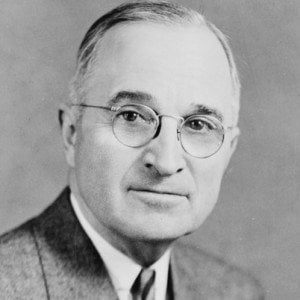 U.S. Recognition of Israel and the Role of President Truman. The U.S. was the first country to recognize Israel as an independent state when on May 14, 1948, President Harry Truman issued a statement of recognition following Israel’s proclamation of independence on the same date.
U.S. Recognition of Israel and the Role of President Truman. The U.S. was the first country to recognize Israel as an independent state when on May 14, 1948, President Harry Truman issued a statement of recognition following Israel’s proclamation of independence on the same date.
Truman’s main motivation was believed at the time, and still is today, the winning of Jewish support in the presidential election that year.
His decision was strongly opposed by Secretary of State George Marshall, Secretary of Defense James Forrestal, the CIA and National Security Council, and top State Department official George Kennan. Intelligence agent Kermit Roosevelt wrote:
“The present course of world crisis will increasingly force upon Americans the realization that their national interests and those of the proposed Jewish state in Palestine are going to conflict.” (p.51)
Contrary to the belief that U.S. oil interests promoted the Zionist project, officials argued that U.S. ability to access Middle Eastern resources would be adversely affected. Truman also had pro-Zionist insiders at high levels of his administration.
Author Alison Weir points out that bribery also played a part. “Gore Vidal wrote:
‘Sometime in the late 1950s, that world-class gossip and occasional historian, John F. Kennedy, told me how, in 1948, Harry S. Truman had been pretty much abandoned by everyone when he came to run for president. Then an American Zionist brought him two million dollars in cash, in a suitcase, aboard his whistle-stop campaign train. ‘That’s why our recognition of Israel was rushed through so fast.’” (p.167)
Jewish businessman Abraham Feinberg explained his raising of cash for Truman in an oral history interview published by the Truman Library in 1973. The CIA also discovered Feinberg’s illegal gun-running to Zionist groups.
I may be the first writer to point out that Truman’s action in accepting bribes, if discovered, could have been seen and treated as an impeachable offense.
Zionist Takeover of Palestine
At the time of Israel’s proclamation of independence and immediate U.S. recognition, the U.N. resolution of partition had been passed, with war ensuing between Zionist and Arab forces.
The U.N. General Assembly adopted the partition plan by 33 votes to 13 with 10 abstentions, with many nations subjected to intense Zionist lobbying and threats. For instance,
“Financier and longtime presidential adviser Bernard Baruch told France it would lose U.S. aid if it voted against partition.” (p.55)
A Swedish U.N. mediator, Count Folke Bernadotte, was killed by Zionist assassins. To this day, no accepted legal authority for the U.N. in its partitioning of Palestine has ever been demonstrated. In other words, it was likely an extra-legal action in response to Zionist lobbying.
Though sporadic violence between Jews and Palestinian Arabs had taken place over the previous two decades, the Zionists committed wholesale massacres of Palestinians after the U.N. resolution for partition.
By the end of Israel’s war of independence in 1948, over 750,000 Palestinians had been expelled from Zionist-controlled territory. Israeli historian Tom Segev wrote:
“Israel was born of terror, war, and revolution, and its creation required a measure of fanaticism and cruelty.” (p.58) Today this is called in Arabic the “Nakba”—“catastrophe.”
The most well-known massacre took place at the village of Deir Yessin in April 1948, before any Arab armies had joined the fight.
There, 254 villagers were murdered in cold blood. The heads of two militias present at Deir Yessin, Irgun and the Stern Gang, were Menachem Begin and Yitzhak Shamir, both of whom later became prime ministers of Israel. The Irgun bombed the King David Hotel in Jerusalem on July 22, 1947, killing 86.
The Stern Gang also solicited aid from the Axis powers during WWII.
Zionist Front Organizations in the U.S.
During the 1930s and 1940s, the Zionists created a number of front organizations to raise money used to finance militant activities in Palestine.
After WWII, the U.S. maintained an arms embargo against Israel and the Middle East. Foremost among the sponsors of the front organizations intended to skirt the embargo was Irgun.
One group, the Jewish Army of Stateless and Palestinians Jews, claimed it was formed to fight the Nazis in Europe, but was intended instead to fight the British and Arabs in Palestine. These groups espoused such radical ideologies as the idea that “non-Jews are the embodiment of Satan, and that the world was created solely for Jews.” (p.67)
Another group, headed by Orthodox Rabbi Baruch Korff, hatched a plot to blow up the British foreign office in London that was exposed in the New York Herald Tribune. Through political influence, U.S. charges against Korff were dropped. Later he “became a close friend and fervent supporter of President Richard Nixon, who called him ‘my rabbi.’” (p.71)
Nixon’s support for Israel manifested in the gigantic airlift of military supplies that helped save Israel from defeat in the 1973 Yom Kippur War. Another major organization raising money for sending arms to the Zionists in Palestine was the Sonneborn Institute. Between 1939 and May 1948, the Jewish Agency for Israel was also active, raising the equivalent today of $3.5 billion.
Financial Backers of Israeli Independence
In an April 19, 2018 article in Tablet (tabletmag.com) entitled “Gangsters for Zion: Yom Ha’atzmaut: How Jewish mobsters helped Israel gain its independence, Click Here Robert Rockaway wrote:
“In 1945, the Jewish Agency, the pre-state Israeli government headed by David Ben-Gurion, created a vast clandestine arms-purchasing-and-smuggling network throughout the United States. The operation was placed under the aegis of the Haganah, the underground forerunner of the Israel Defense Forces, and involved hundreds of Americans from every walk of life. They included millionaires, rabbinical students, scrap-metal merchants, ex-GIs, college students, longshoremen, industrialists, chemists, engineers, Protestants and Catholics, as well as Jews. One group, who remained anonymous and rarely talked about, were men who were tough, streetwise, unafraid, and had access to ready cash: Jewish gangsters.”
Rockaway, a professor emeritus at Tel Aviv University, also wrote that through their control of U.S. ports, the Jewish mob arranged for arms deliveries to Israel aboard vessels flying the flag of Panama.
Recruiting Jews to Relocate to Palestine
“Zionist cadres infiltrated displaced persons’ camps that had been set up to house refugees displaced during WWII. These infiltrators tried secretly to funnel people to Palestine. When it turned out that most didn’t want to go to Palestine, they worked to convince them—sometimes by force.” (p.74)
Another recruiting source was Jewish foster children in Christian homes. The Zionists claimed to be the sole representative of all the world’s Jews in order to legitimize efforts to divert war survivors to Israel, not to countries like the U.S. to which many preferred to go.
“After a voluntary recruitment drive netted less than 0.3 percent of the DP [displaced persons] population, a compulsory draft was implemented.” (p.79)
Some draftees were required to fight in Palestine in the Zionist war of independence. Meanwhile, the secretive Sieff group was formed in Washington, D.C., to carry out back channel lobbying for the Zionist project. The group was protected by such powerful individuals as Supreme Court Justice Felix Frankfurter, Secretary of the Treasury Henry Morgenthau, Jr., and the aforementioned financier and presidential adviser Bernard Baruch.
Fate of the Palestinian Refugees
Three-quarters of a million Palestinian refugees fled to neighboring regions in a gigantic humanitarian disaster. A 1948 State Department report stated
“The total direct relief offered…by the Israeli government to date consists of 500 cases of oranges.” (p.83)
The value of land confiscated by the Zionists amounted to $5.2 trillion in today’s dollars. Christians also suffered as “numerous convents, hospices, seminaries, and churches were either destroyed or cleared of their Christian owners and custodians.” (p.83) Efforts by U.S. government officials to withhold aid to the Israeli government due to the refugee crisis were overruled by President Truman.
Zionism and the Media
Even as early as WWI, the Zionists exerted almost complete control over the U.S. press. This included placing pro-Zionist articles in prestigious newspapers like The New York Times. In 1953, author Alfred Lilienthal wrote:
“The capture of the American press by Jewish nationalism was, in fact, incredibly complete. Magazines as well as newspapers, in news stories as well as editorial columns, gave primarily the Zionist views of events before, during, and after partition.” (p.86)
Zionist coercion extended to withdrawal of advertising, cancellation of subscriptions, and blacklisting of journalists and authors, even those offering a mere trace of sympathy toward the displaced Palestinians.
Particularly emotional in their support of Zionism were the journals the Nation and the New Republic. An example of how the Zionists could destroy an author’s career was the attack on then-famous journalist Dorothy Thompson after
“she began to speak about Palestinian refugees, narrated a documentary about their plight, and condemned Jewish terrorism. (p.92)
We all know that the complete slanting of U.S. media coverage toward Zionism and Israel dominates news reporting at all levels and across the ideological spectrum, from the top newspapers and networks to what is left of small town journalism.
This includes so-called “independent” outlets like Breitbart. The start of this bias began, perhaps not coincidentally, during the time before WWI when the newsrooms of U.S. newspapers were taken over by propagandists sympathetic to the Federal Reserve System and the Money Trust.
Today, of course, we have the internet, which has begun to make inroads into the control of the news by pro-establishment media corporations and Deep State censors. Internet outlets also must be cautious, however, so are often reduced to the role of “limited hangouts,” reporting only selected stories that protest particularly egregious Israeli offenses, but never the “big picture.”
In conclusion we can say that, as Alison Weir’s book makes clear, it was largely American Zionists who financed and enabled the violent takeover of Palestine and who thereby share responsibility over the past three-quarters of a century for the atrocities committed against a diverse population whose forebears had been living in peace and rooted in the region for millenniums.
This population also inhabited the holy city of Jerusalem, sacred to the Jewish, Christian, and Islamic religions.
The book also makes it clear that people can oppose Zionism—the forceful establishment of a Jewish national state in Palestine—without being anti-Jewish or “anti-Semitic.”
Of course, most of the indigenous people of Palestine are “Semites” in ethnicity and language. Also, the most forceful opponents of the original Zionist movement in Great Britain, the U.S., and possibly other nations, have been, and still are, Jews themselves who had successfully assimilated into their host cultures. Examples are the Hassidic Jews of Brooklyn, N.Y., and Jews in Iran who refuse to support Israel.
Many more volumes could or should be written about U.S. enabling of Israel and Zionism and about Israel’s and Zionism’s interference in internal U.S. affairs. I would include an examination of Israel’s possible participation in the JFK/RFK assassinations and the 9/11 attacks, U.S. acquiescence in Israel’s nuclear weapons program, Israel’s links with the Neocons who control today’s U.S. foreign policy, and today’s courting of World War III against more than half the world’s countries, starting with Israel’s nemesis, Iran. Will the U.S. stumble into WWIII because of its pro-Zionist captivity?
*
Note to readers: Please click the share button above. Follow us on Instagram and Twitter and subscribe to our Telegram Channel. Feel free to repost and share widely Global Research articles.
Richard C. Cook is a retired U.S. federal analyst who served with the U.S. Civil Service Commission, FDA, the Carter White House, NASA, and the U.S. Treasury. As a whistleblower at the time of the Challenger disaster, he broke the story of the flawed O-ring joints that destroyed the Shuttle.
After serving at Treasury, he exposed the disastrous flaws of a monetary system controlled by private finance in his book We Hold These Truths: The Hope of Monetary Reform. As an adviser to the American Monetary Institute and while working with Congressman Dennis Kucinich, he advocated the replacement of the Federal Reserve System with a genuine national currency. His latest book is Our Country, Then and Now (Clarity Press, 2023). Click Here


